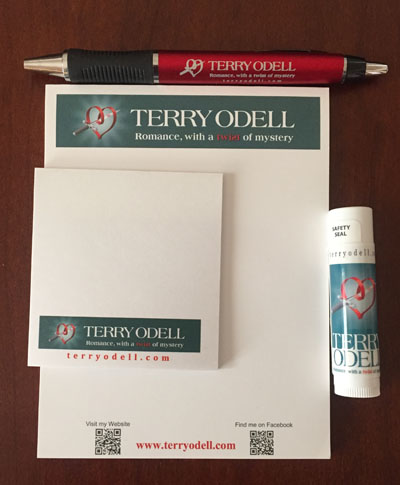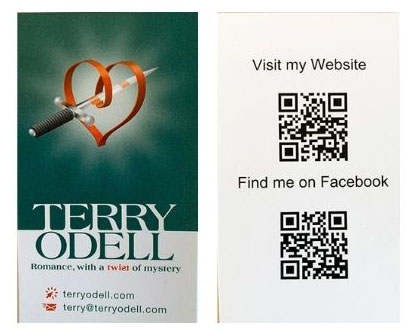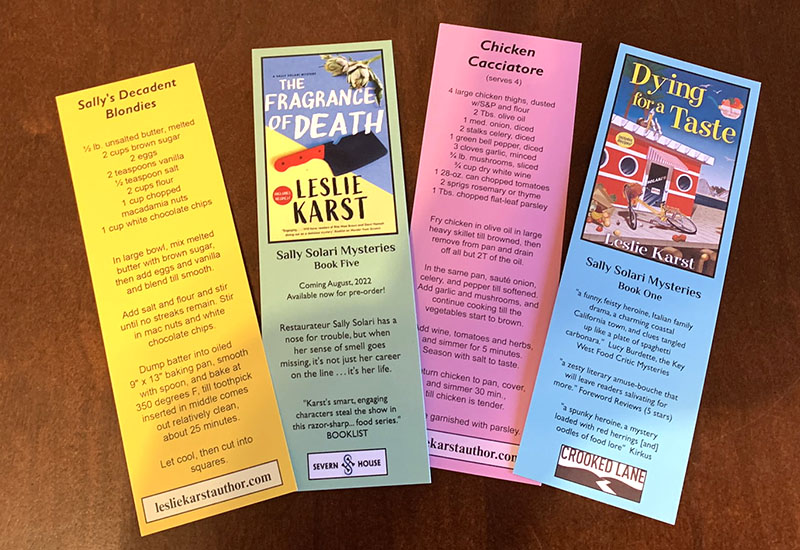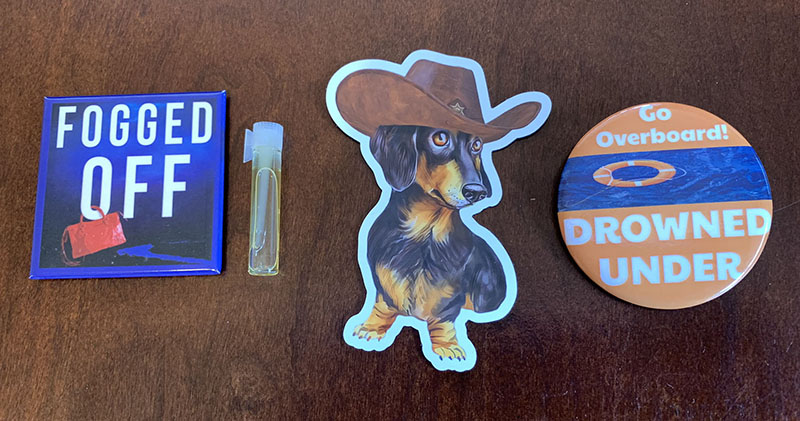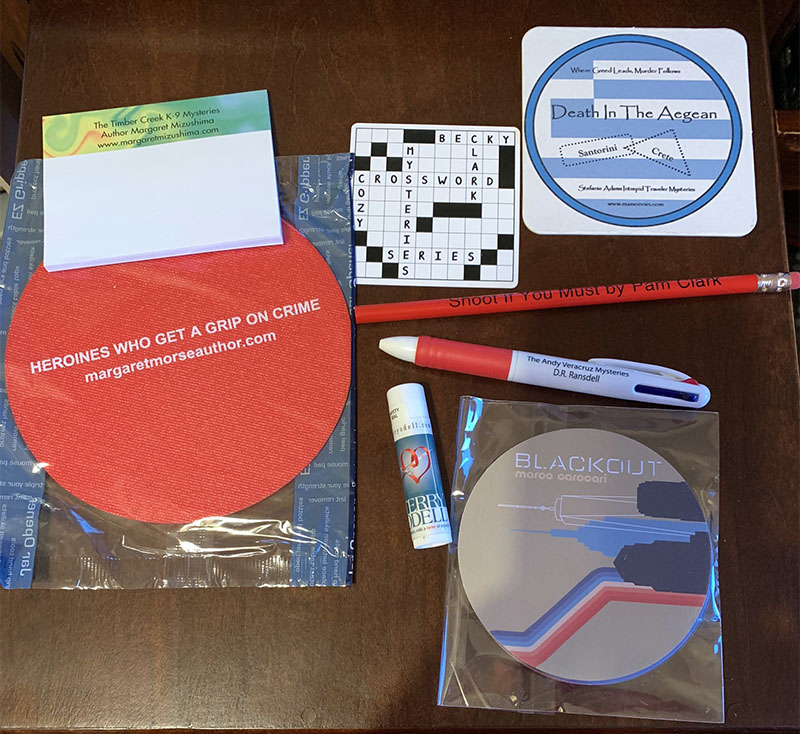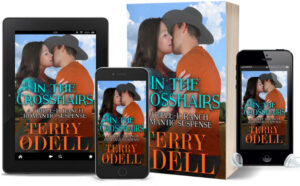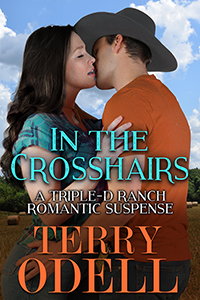
Panorama pic of Left Coast Crime 2019 Swag Table
In recent years, the bags of free goodies celebrities receive for going to awards shows or film festivals has become the stuff of–well, if not of legend, then over-hyped fodder for gossip sites and their related television shows. These “swag bags” often contain things like vacations, certificates for plastic surgery (booty lift, anyone?), jewelry, designer duds, catering, gaming systems, computers, booze, beauty products, therapy consultation, car leasing, protein bars, and much, much more.
If you’ve been to a book festival or conference, you know that attendees sadly must settle for less.
Back in the 00’s, a fan might pick up the occasional button, keychain, or bookmark. (Much to author Bill Cameron’s puzzlement, I still have a button with his LOST DOG (2008?) cover, and put it on my Christmas tree every year.) Now, it seems that the majority of authors attending conferences are giving at least a little something away with their name, website, and book cover to potential fans. When the number of authors at a conference can run well into the hundreds, you’re talking about a lot of stuff.
Over the years I’ve given away bookmarks, laminated magnets, flower seed packets, plain magnets, chip clips, lots of candy (not branded), postcards, and did I mention bookmarks? Those were all paid for directly out of my pocket. For THE STRANGER INSIDE, Mulholland Books created some kick ass keychains to give away at a Little Brown event at Bouchercon in St. Petersburg. I snapped up the five or six left on abandoned tables after the event. (Never leave your swag behind!) I never could’ve afforded to sponsor such a high-value bit of swag myself, so I was very, very grateful.
As I’ve just returned from Left Coast Crime 2019, Whale of a Crime, in Vancouver, BC, I thought I’d share my thoughts on the immense amount of swag I saw there. No, I didn’t ask any of these authors if I could post photos, as the items are–I assume–meant to advertise their books. But I did take the photos, and they itched to be shared. If you’re promoting your own work already, or someday will be, I hope they’ll be useful to you. Pics are in no particular order.
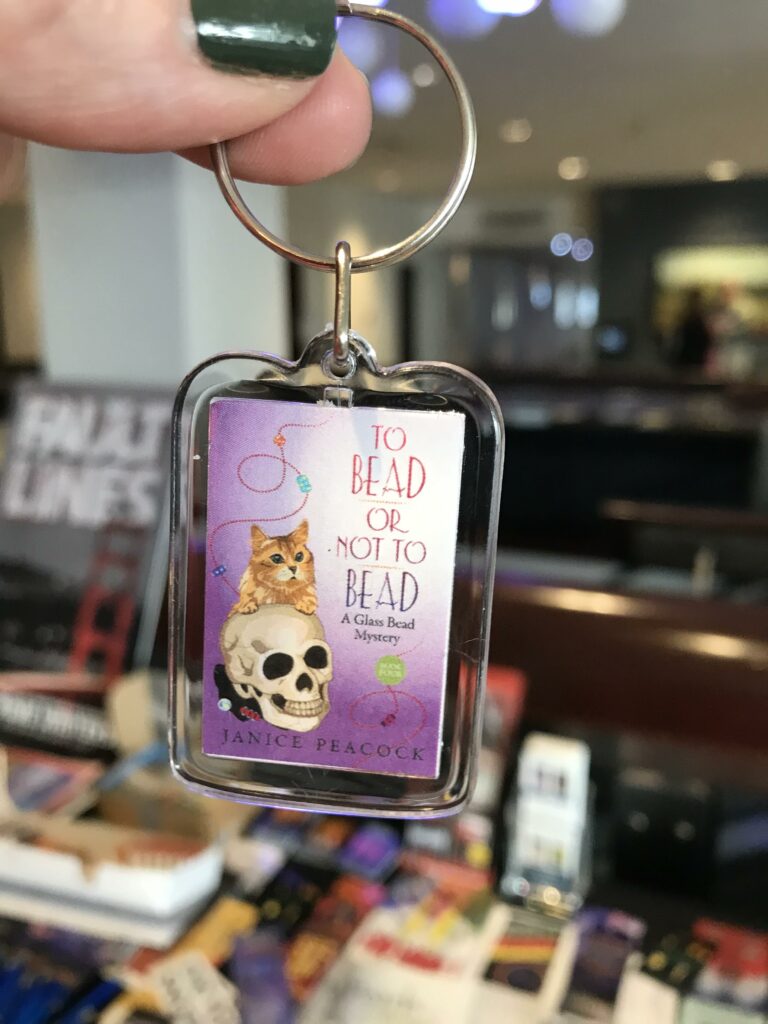
KEYCHAIN: This was one of my favorite bits of swag. Janice Peacock/To Bead or Not to Bead. The cover is charming and colorful, and a keychain is one of those items that’s going to hang around a long time. Unfortunately, no website address. $$$
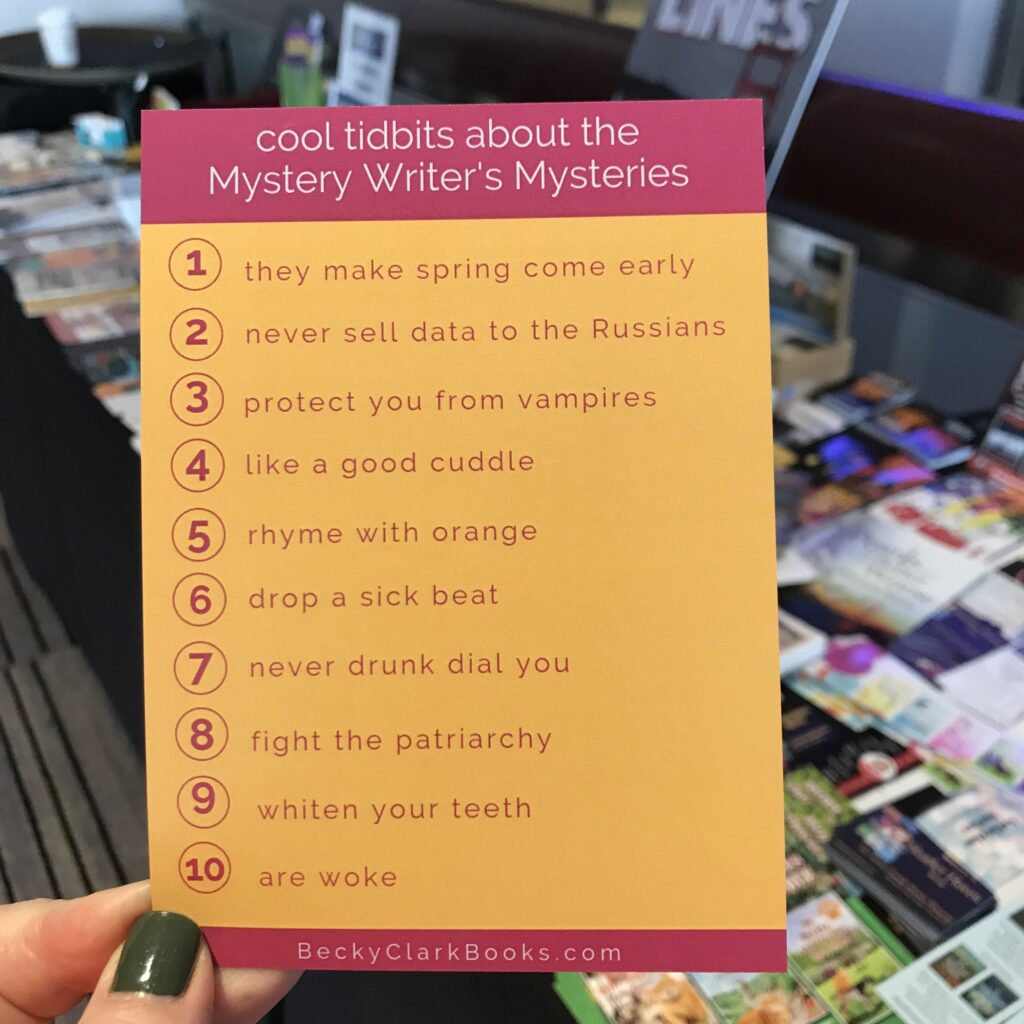
CARD LIST: I wasn’t sure what to call this, so “card list” it is. I had to read the list and the headline a couple of times before I understood that it was just for fun. Used online, this would make a cute Facebook or Pinterest image. As clever as it is, I would’ve liked to have seen at least one of the book covers as well. I went to Becky Clark’s “Books” page to see that Mystery Writer’s Mysteries is a collection of books featuring mystery authors. When I first saw the card I thought it was maybe a group of authors who wrote them. Bonus points for eye-catching colors, website addy, and stand-out size. $
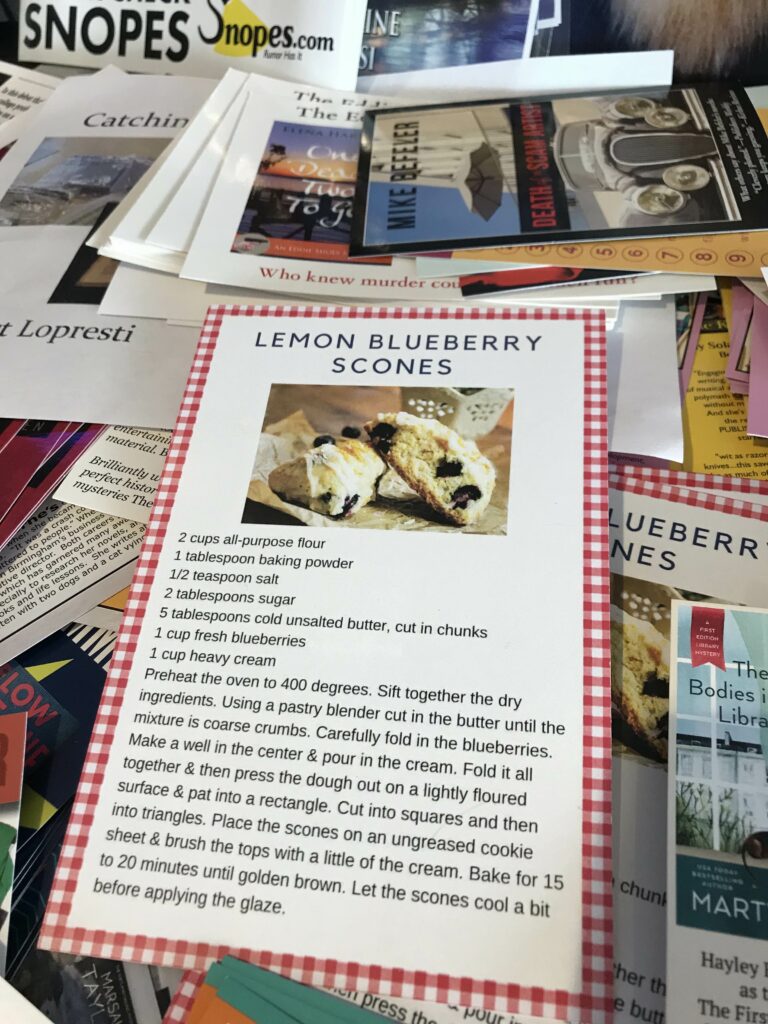
RECIPE CARD: How lovely is this?! Coincidentally I have been wanting to make scones. Unfortunately, it doesn’t have any identifying information–as though it’s at the wrong conference. I assume there’s book and author information, and perhaps a book cover on the reverse side. As you can see in the photo, the stack is similarly placed. NOTE: The swag table is a crowded place–you can’t expect a browser to turn every thing over to see what’s on the back. Be sure you have book and author information on BOTH SIDES.
Four-color printed, large card: $$
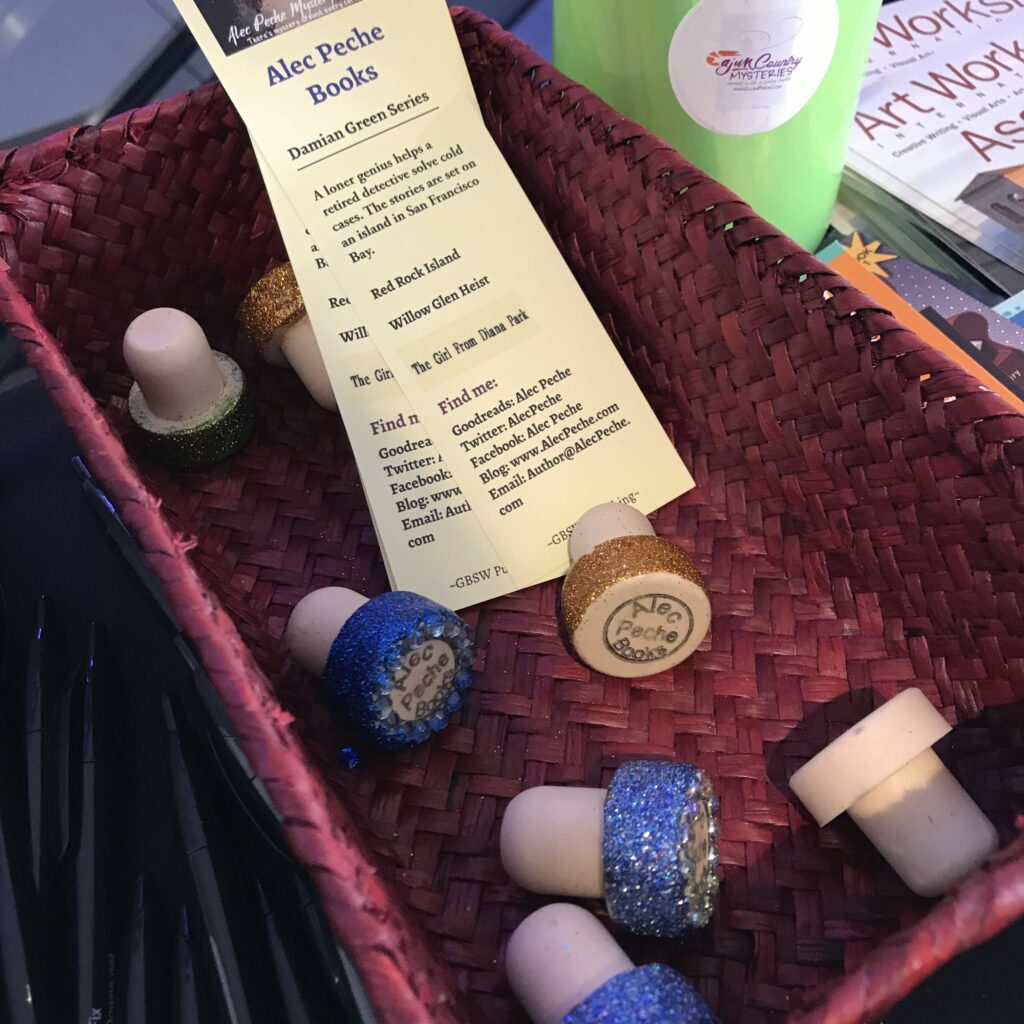
WINE STOPPER: Unique at the conference. Good author name presence, especially with the added bookmark. Alec Peche/Damian Green Series. Visited her website to see if the books were wine related. They don’t appear to be, but lots of people drink wine like they use keychains, bookmarks, etc. $$$
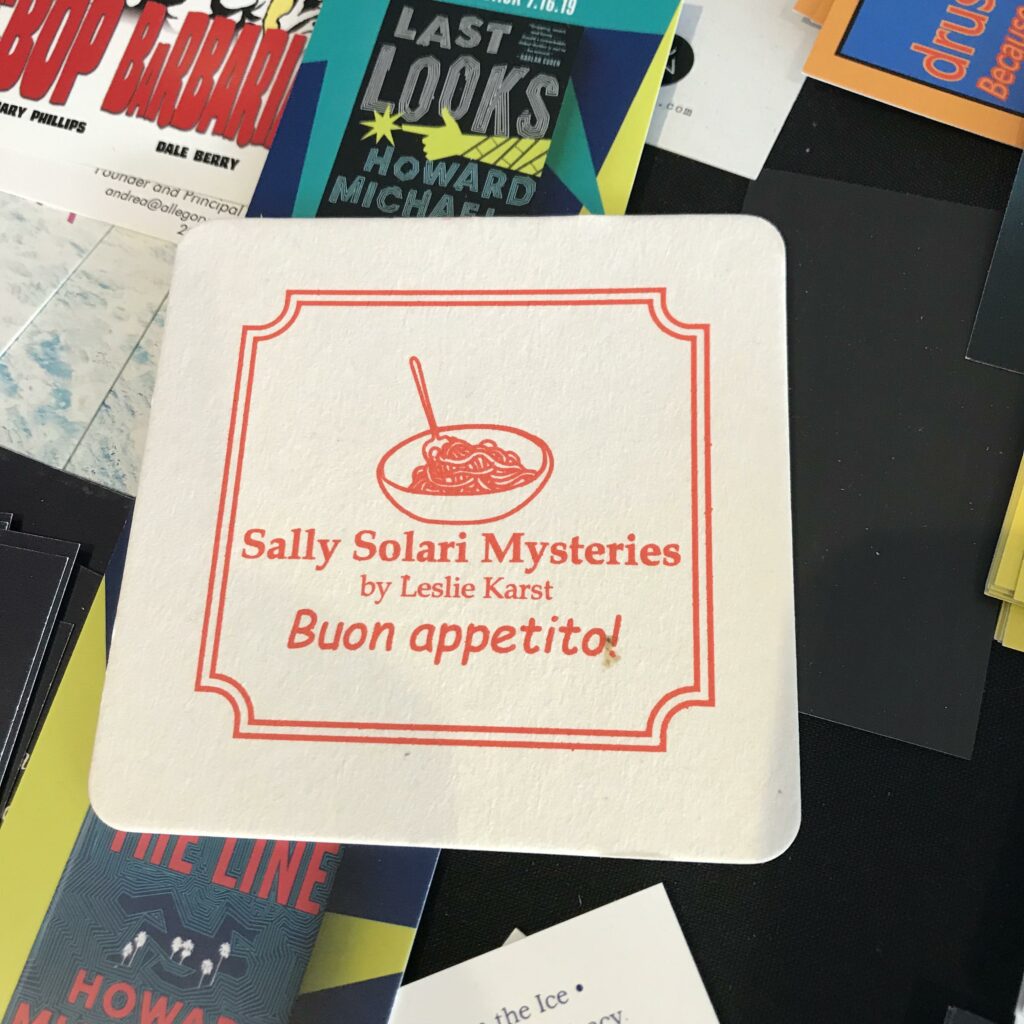
DRINKS COASTER: On theme, useful, and good information. Could use a website address. These went quickly. Leslie Karst/Sally Solari Mysteries $$$
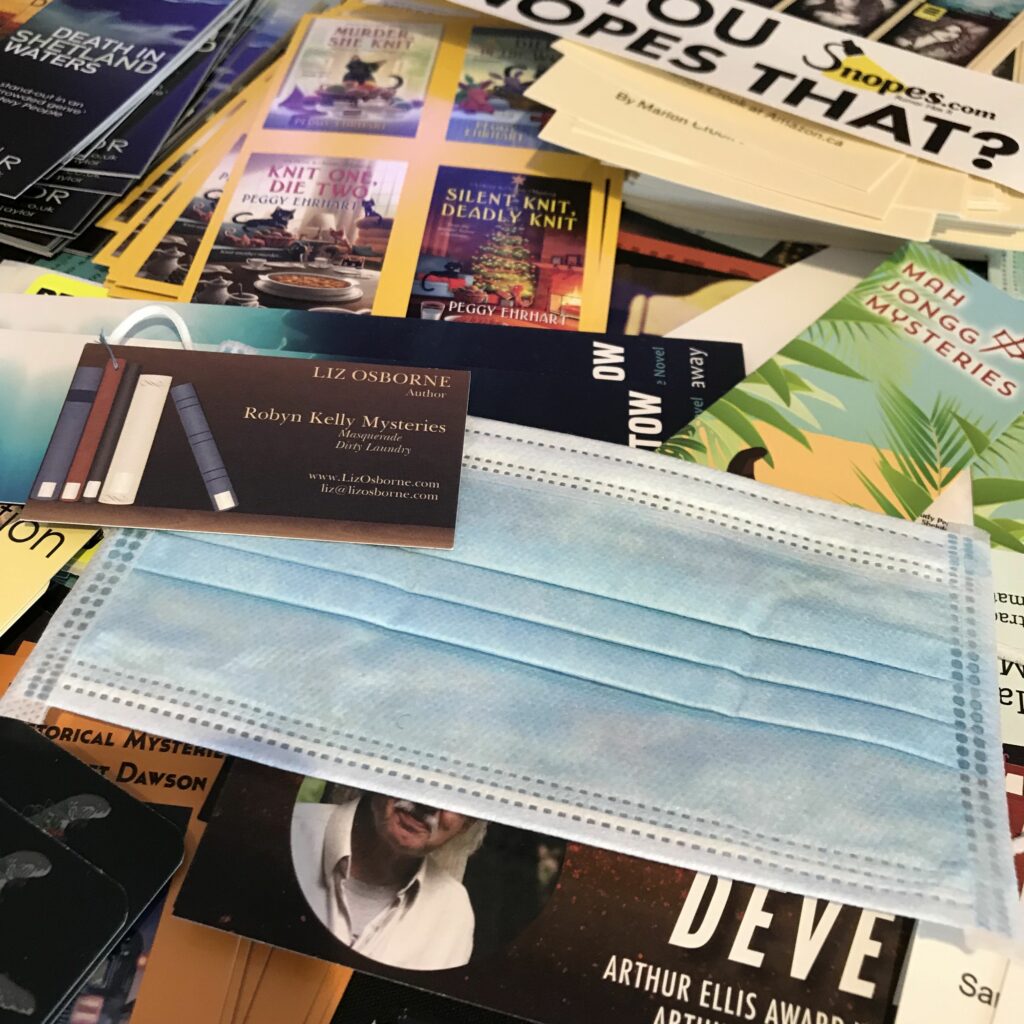
SURGICAL MASK: Another unique item–meaning no one else brought them. I found this both charming and a little alarming. At first I thought maybe the books were Michael Crichton-type horror books, but they’re hospital mysteries. I breathed a sigh of relief! Card attached to the mask with good information. Again, these went fast. (There was no shortage of folks wearing surgical masks on the streets of Vancouver!) Very on-theme. Liz Osborne/Robyn Kelly Mysteries $$$
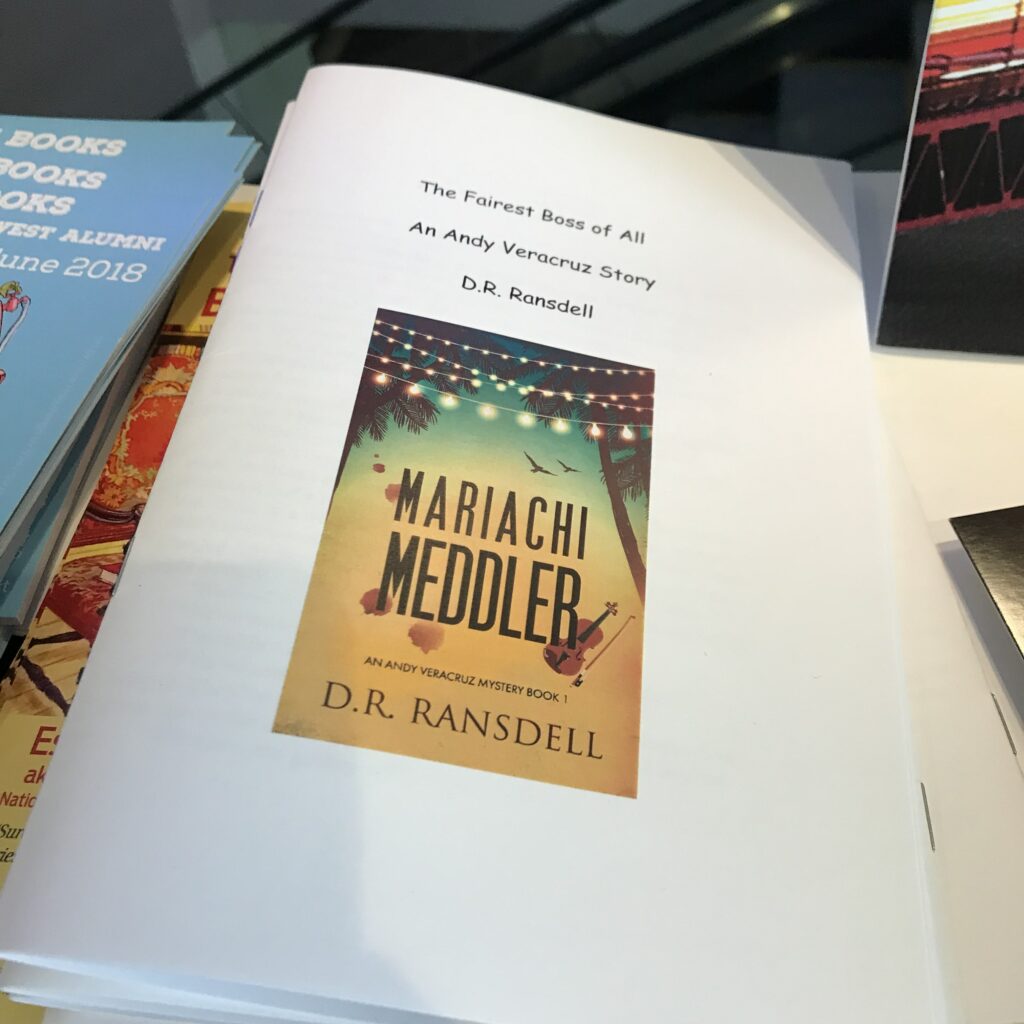
PRINTED SHORT STORY: Content! Smart offering. Eye-catching and large. (Large might be a drawback, as attendees take home many books and might not have much room for more.) Good to mention it’s a story in a series universe. No website address? D.R. Ransdell/MARIACHI MEDDLER $$
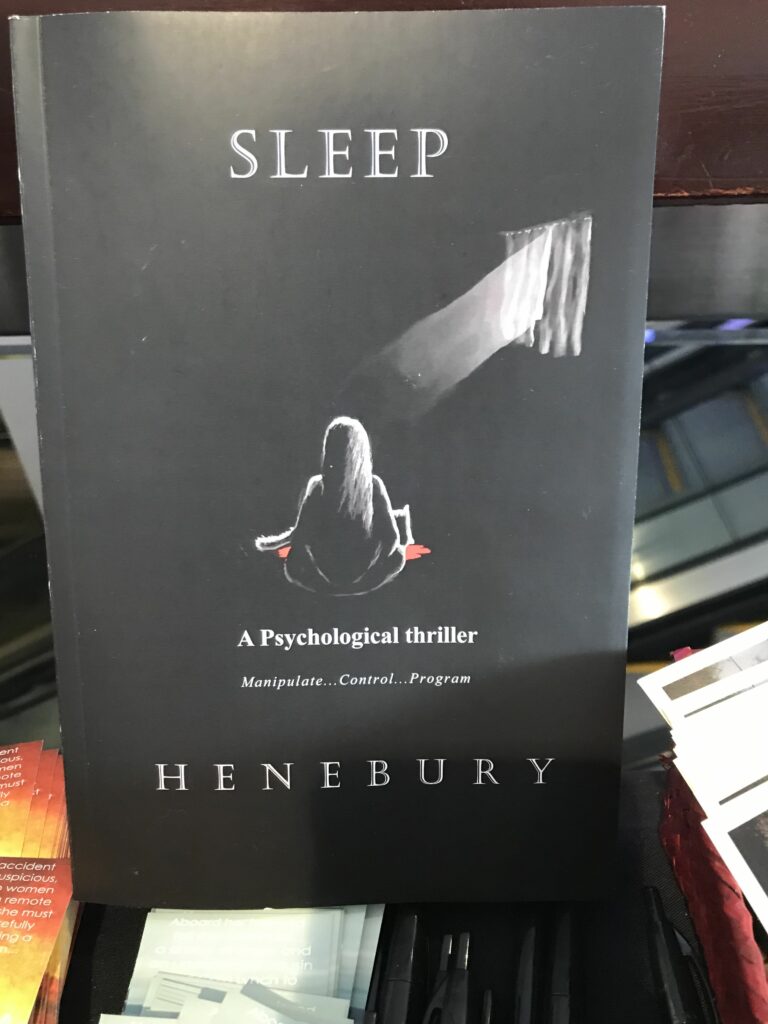
PAPERBACK BOOK: Not sure if this paperback was meant to be a giveaway, or if it’s related to the black pens in front of it. I didn’t see any other copies. Very cool cover. Henebury/SLEEP $$$$
Publishers often give away paperback ARCs (Advance Reader Copies) at conferences. It’s a pricey option, but there’s nothing better than getting an actual book, IMO.
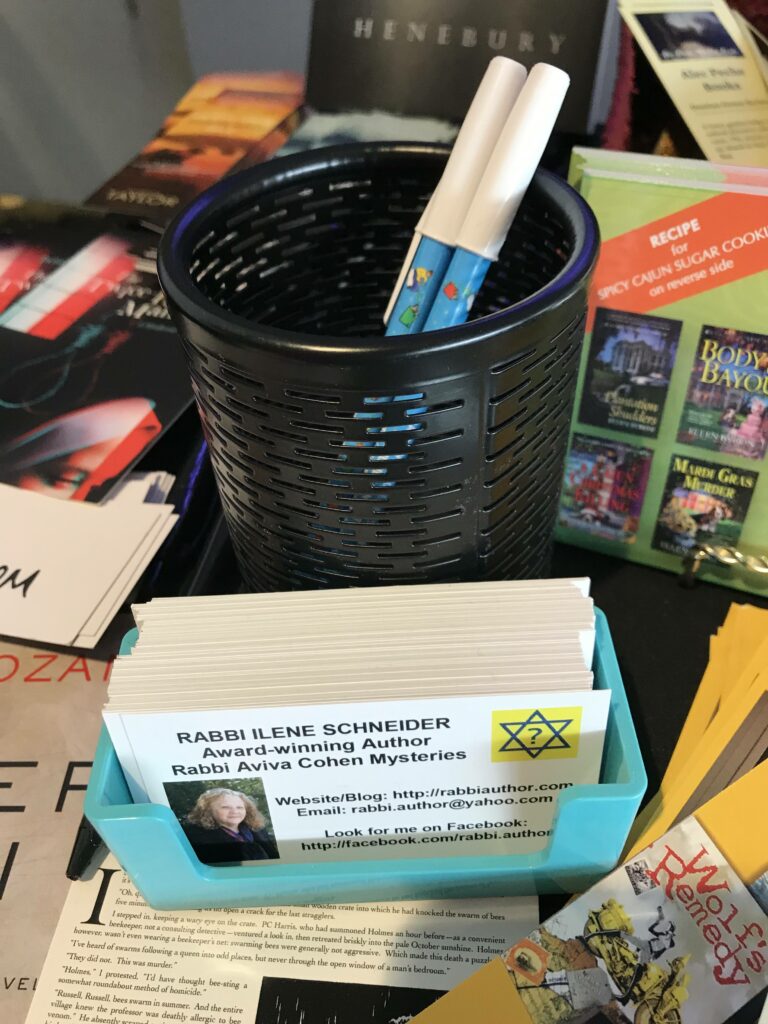
PEN/CARDS: I liked this combo a lot. The pens were adorable, and had the book series name and website (as I recall). The cards offered every other bit of info you could want. Plus an author pic. If there hadn’t been colorful pens, I think I’d have wanted to see a book cover. Also, a rabbi writing about a rabbi is a fascinating combo. Rabbi Ilene Schneider/RABBI AVIVA COHEN Mysteries $$$$
When you have multiple items, there’s a chance they’ll get separated. (Note Alec Peche’s useful box above) And you’ll notice that the pens went way faster than the cards. So the pens need maximum info.
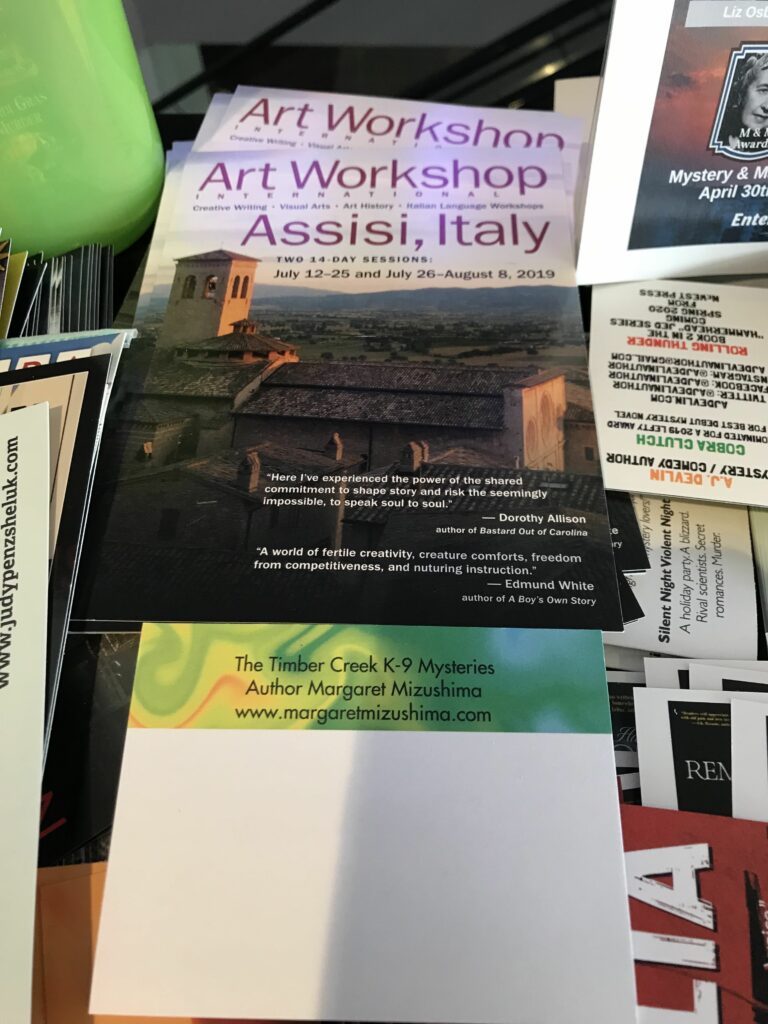
TWOFER
CONFERENCE CARD (large): It’s not just authors who promote. There were quite a few offerings from workshops and retreats. IDK if there’s info on the back, but there’s no website on the front. Again…Everything should be obvious and immediate. Colorful and eye-catching. $$
STICKY NOTES: Colorful, useful, informative. These sticky notes are a great giveaway. The author’s name and website is right there, along with the name of the series. Sticky notes can hang around a desk a long time. Pricey. $$$$
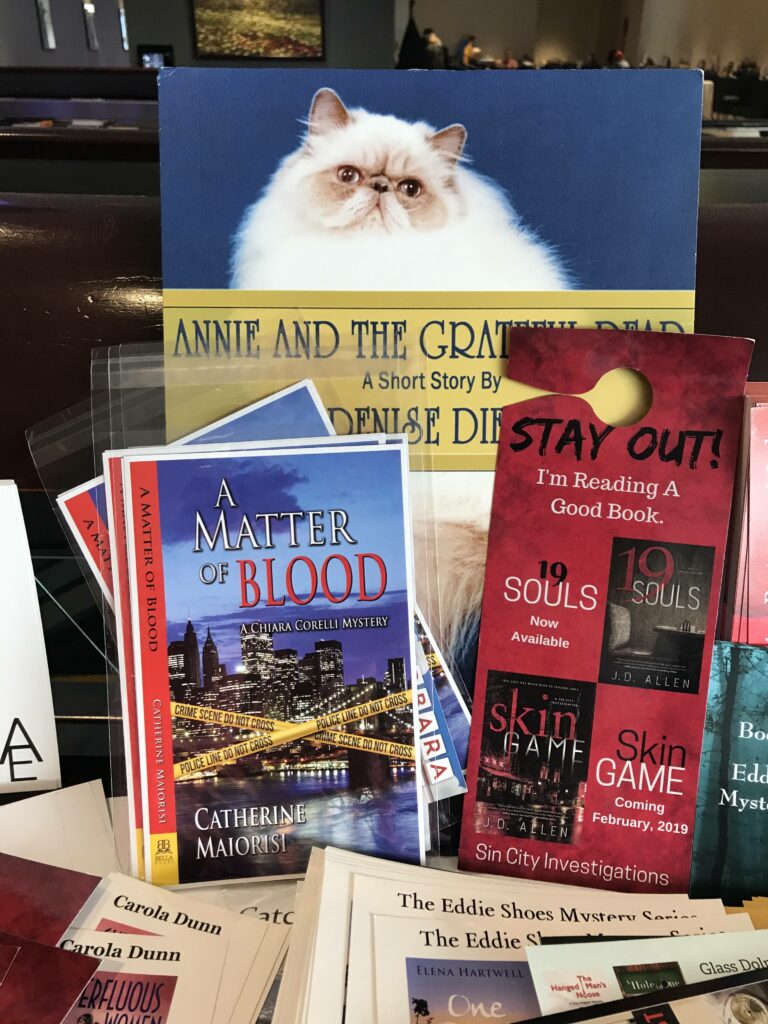
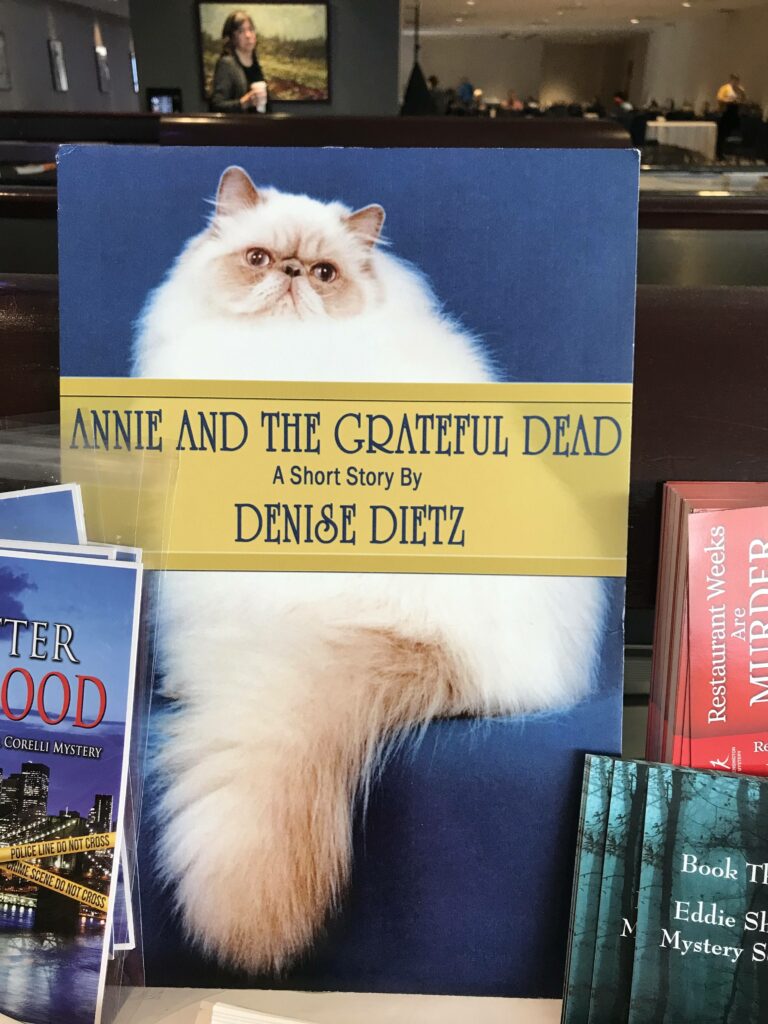
STANDING POSTER: See what I mean about things getting covered up? I had to rearrange things to get the full poster shot. It’s smart that she made it so large that it could tower over the stuff people put in front of it. Real estate is precious. I don’t know if there were copies of a short story to go along with the poster, but wouldn’t you think so? The cat kills me! Bonus points for excellent design. Website addy? Denise Dietz/Annie and The Grateful Dead. $$ for just the poster, $$$ if story copies were included.
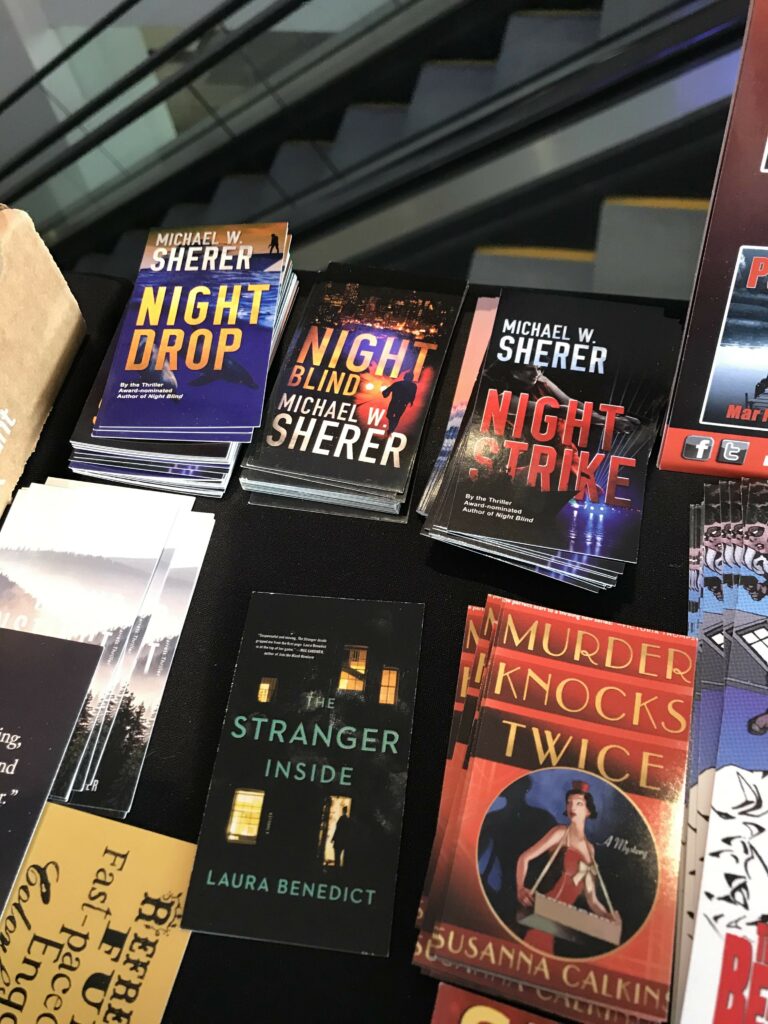
TWOFER, though it doesn’t look like it
MAGNETS: Magnets used to be super expensive. They involved sealing an image and putting a magnetic back on it. Now they can print on long strips of magnet.
This is my moment of shame: Great cover for THE STRANGER INSIDE, yes? Magnets hang around a long time on refrigerators or on metal filing cabinets, etc. Note the bits of white on the edges of my magnet. When the magnets were cut from sheets, they didn’t cut cleanly, and some of the black edge was exposed as white. Ugh. Also, this last magnet shows fingerprints. No website addy. $$
Note: You can’t tell the difference between the magnet and the four-color cards surrounding it. That’s a problem. Unless someone picks it up, they’ll never know what it is. Magnets are great to hand out directly, say at book festivals and signings. But they’re useless flat on a table. I did do bookmarks as well, though. They have all the info.
CARDS: The number of beautifully produced cards was astonishing. Michael W. Sherer’s were particularly high quality and had great variety. Useful if information is on the back. Book covers are striking. If they’re striking enough, people may be moved to pick them up to investigate. They also have a collectible quality about them, and make good bookmarks.
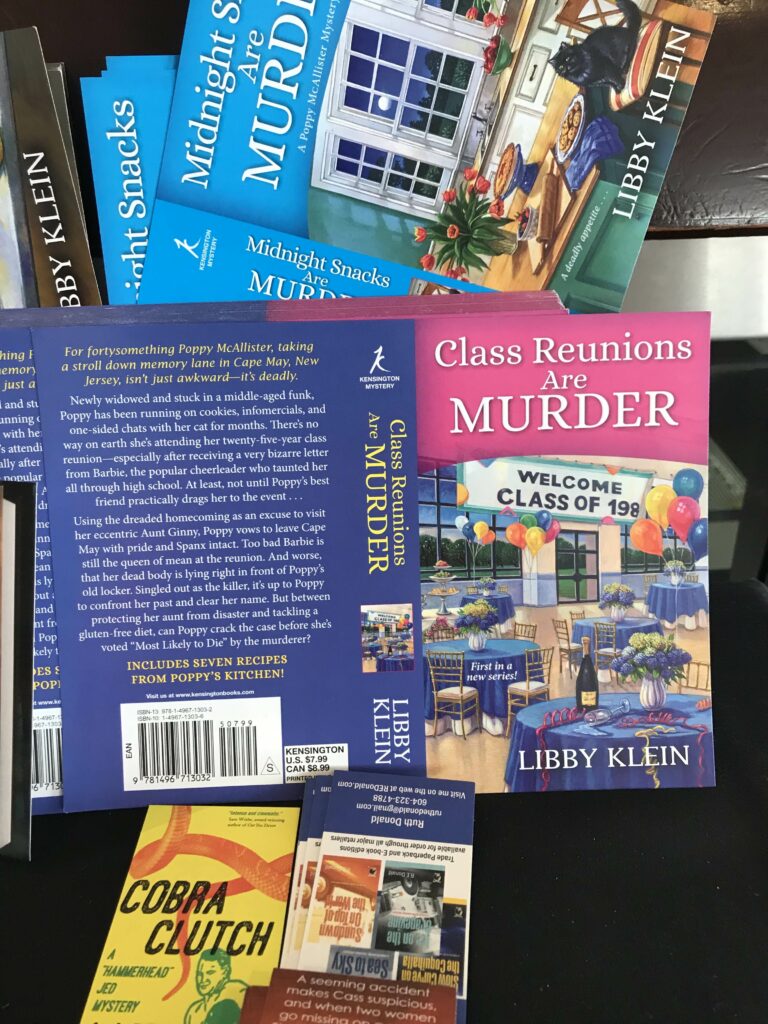
BOOK COVERS: Colorful, all the information about the author, and the book. Author Libby Klein had several versions of these. They seem to be bigger than postcard size. Maybe they are actual book covers? Interesting souvenir. $$$
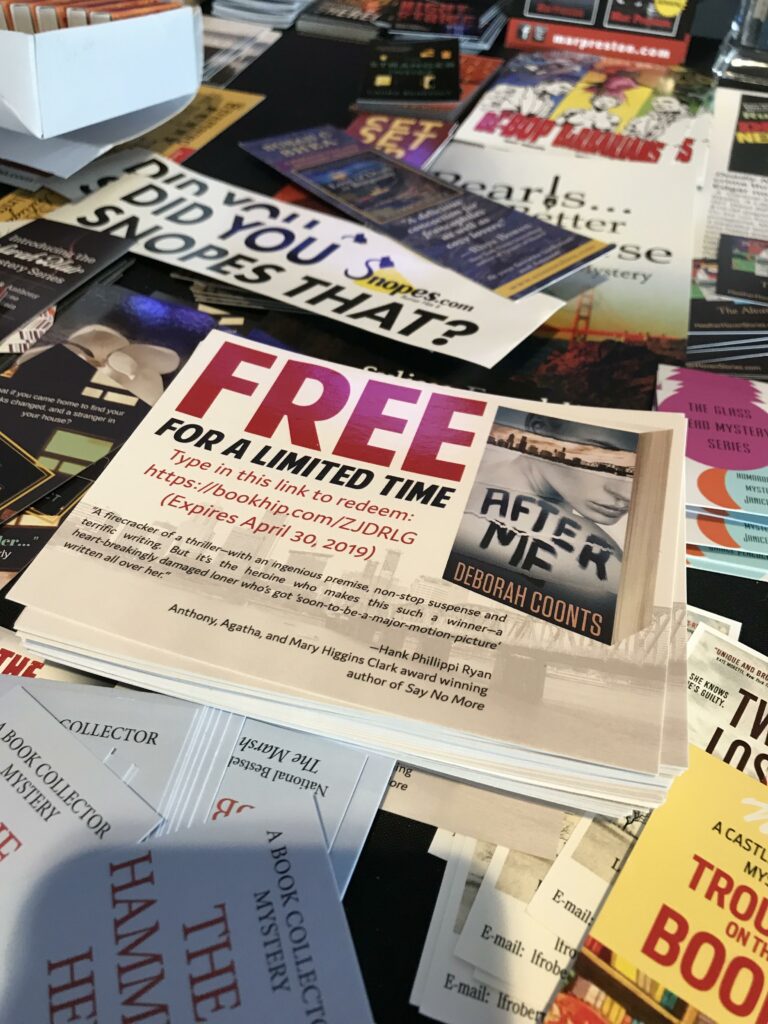
FREE PROMO CARD: Deborah Coonts/AFTER ME. Striking size and design. Lots of good information, including cover, synopsis, blurb, and download code. No website addy? (I didn’t look at the back). $$ or maybe $$$ including the download.
I did a free download of a short story on a bookmark for my sixth book. I didn’t have all that many downloads, but it is a clever gimmick and a great freebie. The idea that you have to type in the address and can’t just click on the picture is still funny to me.
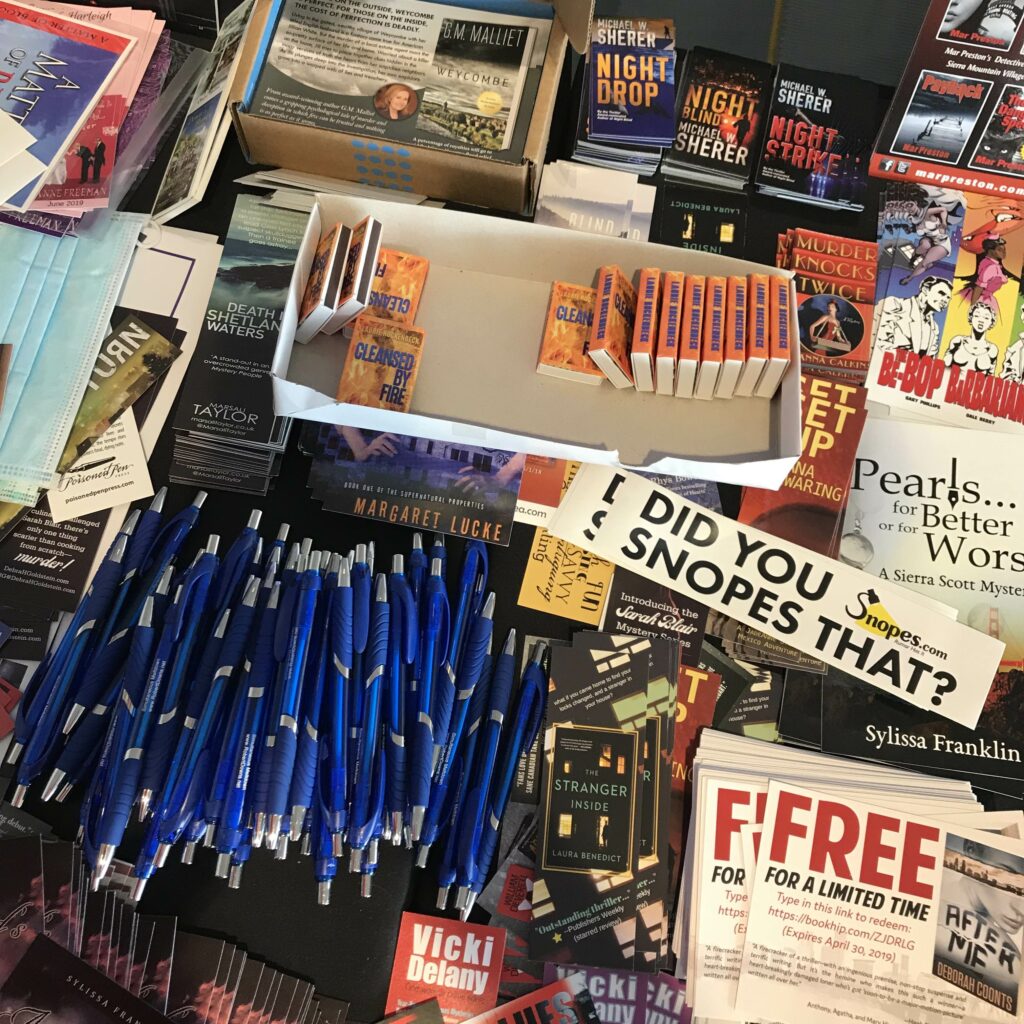
OTHER STUFF
BOOKMARKS: Bookmarks are the go-to swag for the thrifty author. They’re useful, colorful, have the book’s cover, and room front and back for lots of critical information. I also include blurbs, the pitch line, and website address. $
MATCHES: This was a first for me. I believe they are simply the cover, and matches. Talk about on-theme! Very cool. $$$
BUMPER STICKER: I didn’t know SNOPES was at the conference…Interesting concept, though I’ve never seen a book bumper sticker. Ever. Not even on that weird car that’s so covered with bumper stickers that you can’t see the color of the car anymore. $$$
PENS: Pens are stupidly expensive. I love them, but am very wary of poor quality. They also have limited room for your info. Book or series title and website seem to be the most common/useful. $$$$
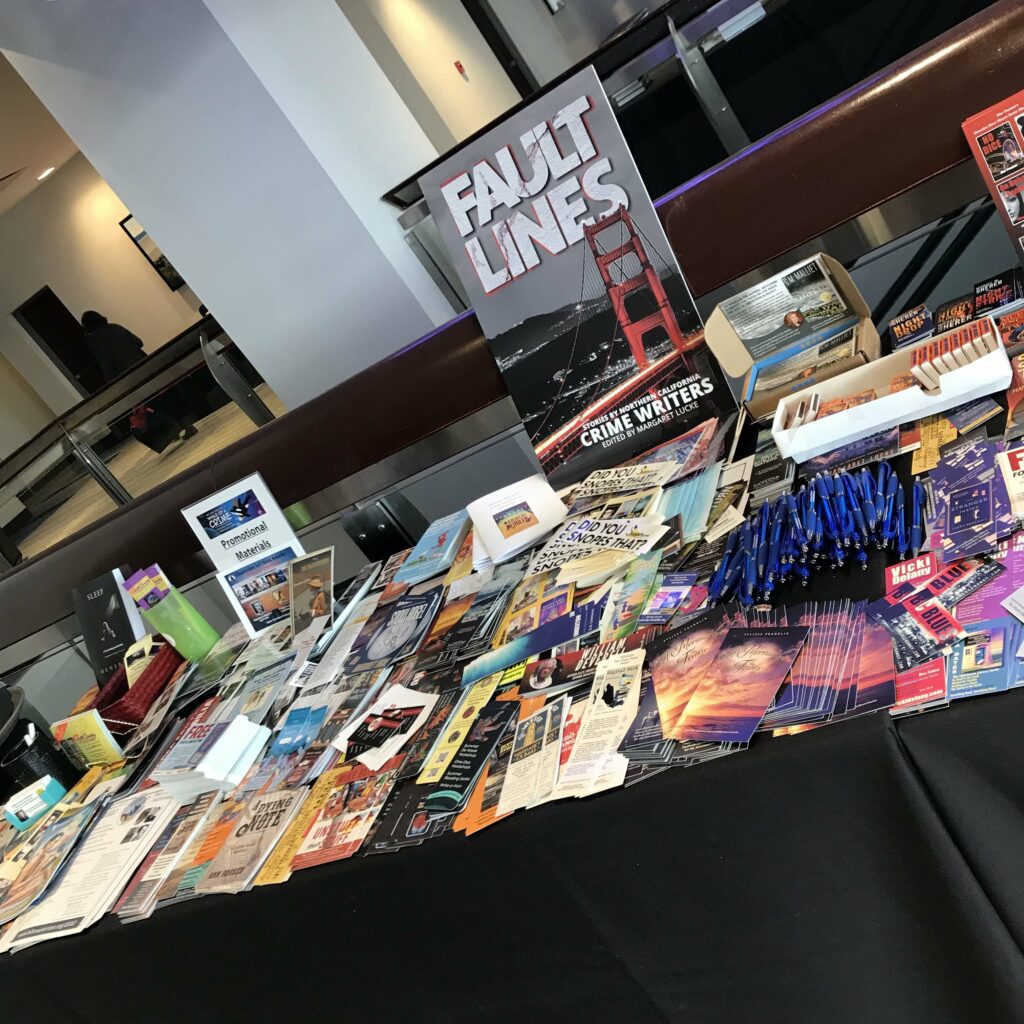
I’m sure I’ve forgotten something. Authors are very creative when it comes to promo.
Final thoughts. Look at that table! IMO the conference could have used a second swag table. This one was like a tiny, violent sea, with flotsam and jetsam constantly bobbing and bumping on its surface. It became a kind of game to see how my own magnets would appear and disappear, or pop up in different places when I dropped by. I was stunned when the big box of matches appeared, sitting on a dozen other offerings.
Keep in mind:
Swag costs money. Spend wisely.
Your stuff is going to get covered up by other stuff. Keep an eye on it.
Don’t be a jerk and cover up other writers’ stuff.
Don’t put out magnets unless you don’t mind spending the money to have people not pick them up because they don’t know what they are.
Don’t be hurt if you have swag left over. Take it home for the next event or to your library.
IDENTIFY YOURSELF ON BOTH SIDES.
Include your website.
Buy the highest quality swag you can afford. But don’t go into debt for it. Who knows what the return is?
If you stick a couple dozen in your badge pocket, you can give your bookmark/magnet/card to everyone you meet.
Have fun with it!
Okay, TKZers. Have at it. What’s your swag experience? Are you fer it, or agin it? What’s your favorite swag? Has swag ever led you to buy a book?
 I’m back from Left Coast Crime, and I just know that you’ve all been waiting with bated breath to see how things went on the “Behind the Badge” panel.
I’m back from Left Coast Crime, and I just know that you’ve all been waiting with bated breath to see how things went on the “Behind the Badge” panel. Like bang for your buck? I have a new Mapleton Bundle. Books 4, 5, and 6 for one low price.
Like bang for your buck? I have a new Mapleton Bundle. Books 4, 5, and 6 for one low price. Terry Odell is an award-winning author of Mystery and Romantic Suspense, although she prefers to think of them all as “Mysteries with Relationships.”
Terry Odell is an award-winning author of Mystery and Romantic Suspense, although she prefers to think of them all as “Mysteries with Relationships.”

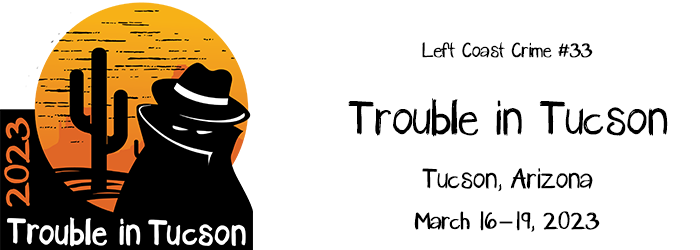 I’m in Tucson for the Left Coast Crime Conference, so forgive me if I don’t respond to comments right away.
I’m in Tucson for the Left Coast Crime Conference, so forgive me if I don’t respond to comments right away.

